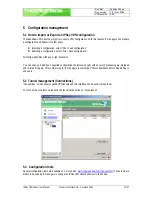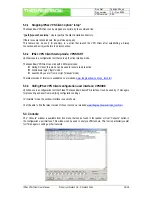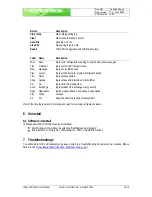
Doc.Ref
TgbVpn25x_en
Doc.version
1.2 – Nov.2004
VPN version
2.50
IPSec VPN Client User Manual
Property of Sistech SA - © Sistech 2004
14/14
4.5.1
Settings description
Name
Label for IPSec Configuration only used by the VPN client. This parameter is
never transmitted during IPSec Negotiation. It is possible to change this name at
any time and read it in the tree list window. Two Phases can not have the same
name.
VPN Client address
Virtual IP address used by the client inside the remote LAN: The computer will
appear in the LAN with this IP address.
It is important this IP address not to belong to the remote LAN (e.g., in the
example, you should avoid an IP address like 192.168.1.10)
Address type
The remote endpoint may be a LAN or a single computer. In the first case
choose "Subnet address". Choose "Single address" otherwise.
When choosing "Subnet address", the two fields "Remote LAN address" and
"Subnet mask" became available.
When choosing "Single address", only the field "Remote host address" is
available.
Remote address
This field may be "Remote host address" or "Remote LAN address" depending of
the address type. It is the remote IP address, or LAN network address of the
gateway, that opens the VPN tunnel.
Subnet mask
Subnet mask of the remote LAN. Only available when address type is equal to
"Subnet address".
ESP encryption
Encryption algorithm negociated during IPSec phase (3DES, AES, ...)
ESP authentication
Authentication algorithm negociated during IPSec phase (MD5, SHA, ...)
ESP mode
IPSec encapsulation mode : tunnel or transport
PFS group
Diffie-Hellman key length.
Auto open when
Client starts
If checked, this option allows a tunnel to be automatically opened when the VPN
Client starts.
Note: as the VPN Client may also start during the boot (see section VPN
Tools), tunnels can be configured to be opened automatically during the
boot of the computer.
Auto open when USB
stick plugged in
If checked, this option allows a tunnel to be automatically opened when a USB
stick is inserted (see chapter "USB mode").
Open Tunnel
This button allows opening directly the tunnel without using a ping for example.
Once the parameters are set, click on “Save & Apply” to save and to take into account the new configuration.
You’ll find a set of useful VPN Client configuration documents available for each of the VPN Client gateway we
support. Please go to our knowledge base on our website:
http://www.thegreenbow.com/vpn_gateway.html
4.6
Certificate management
TheGreenBow IPSec VPN Client uses X509 certificates with PEM format. This kind of certificates is created with
OpenSSL, not with TheGreenBow VPN Client.
Important: You’ll find documents on “How to generate certificates” or “How to convert certificate formats” on our
website:
http://www.thegreenbow.com/vpn_doc.html
and
http://www.thegreenbow.com/vpn_tool.html






































